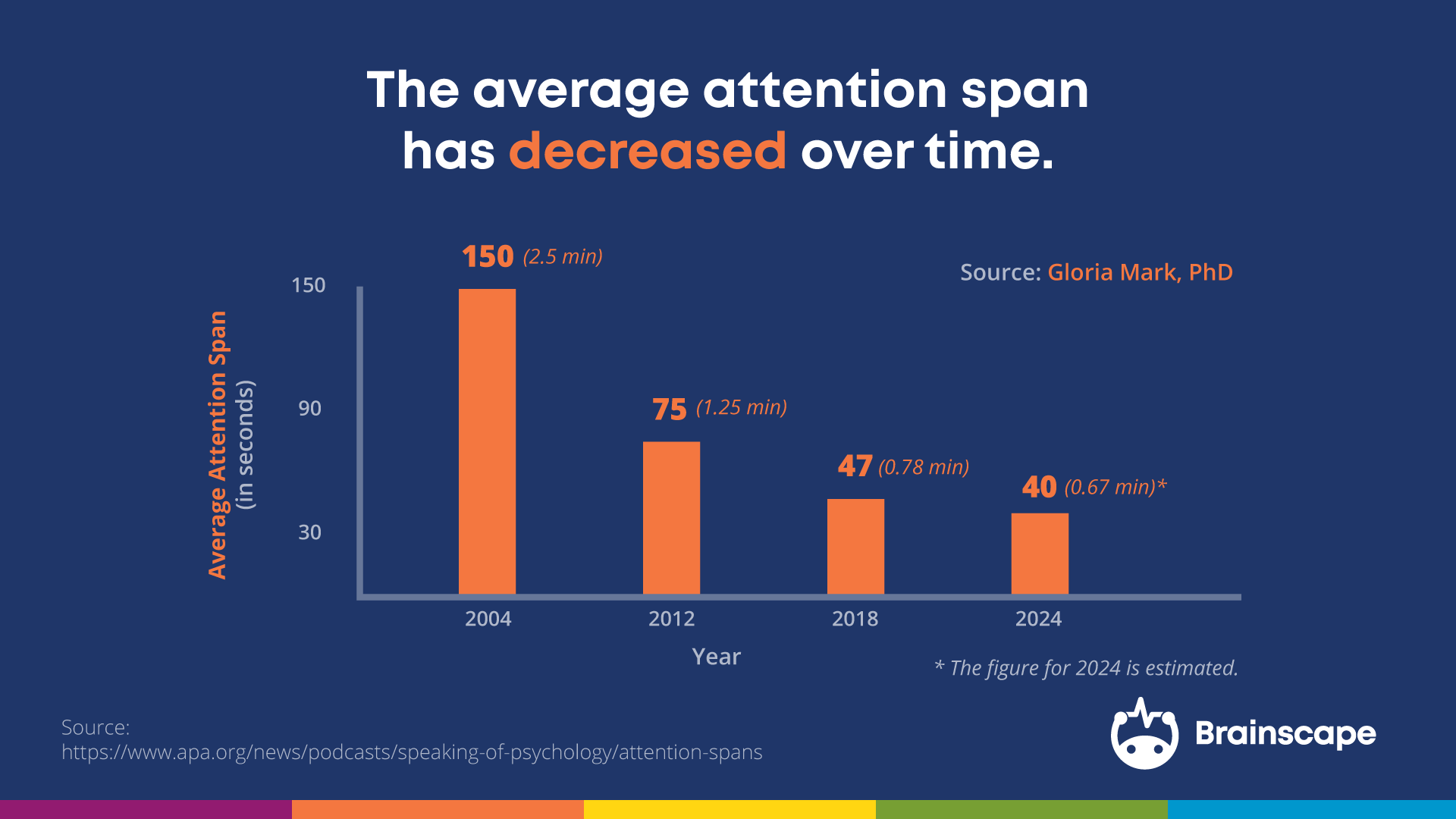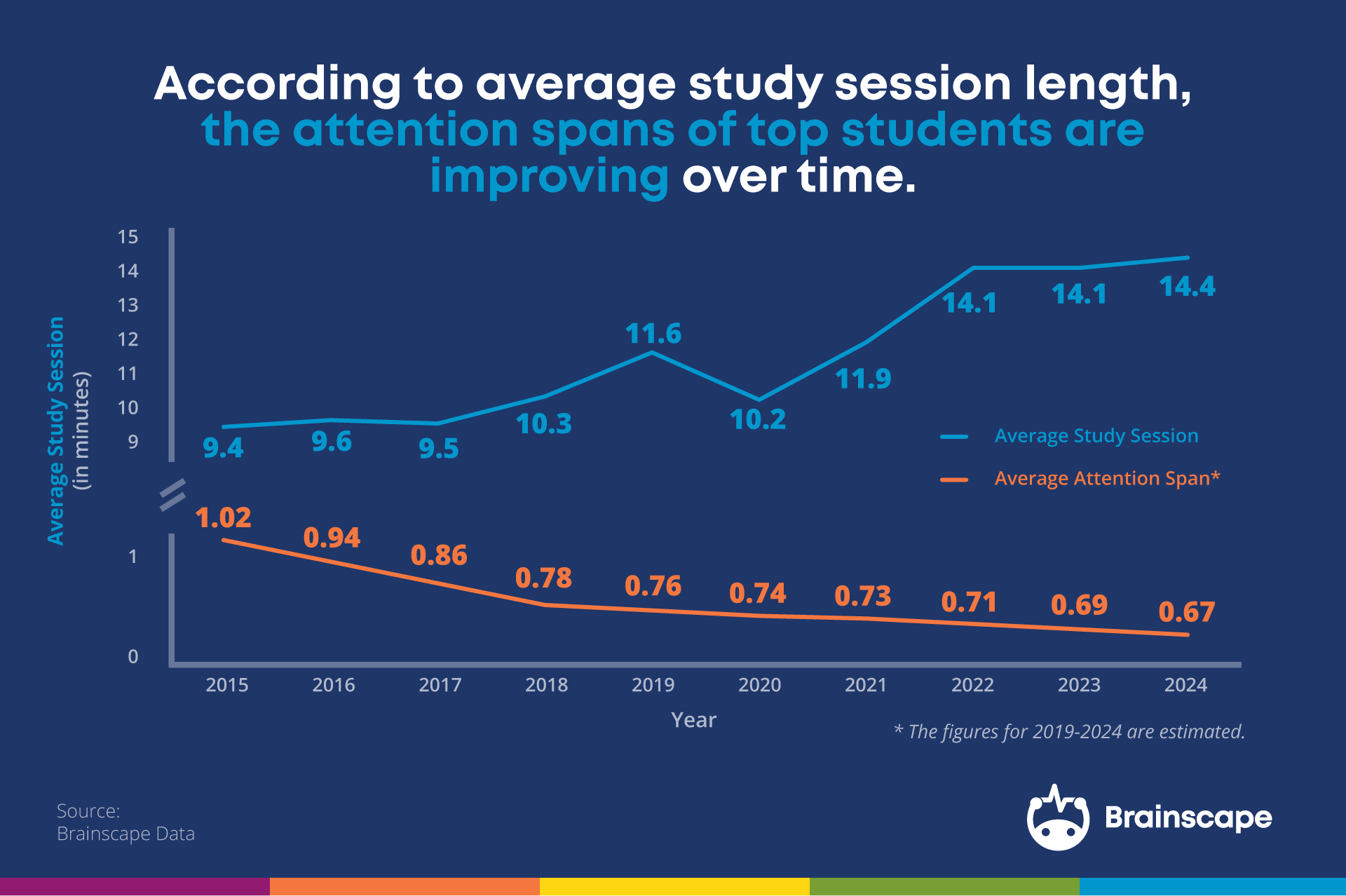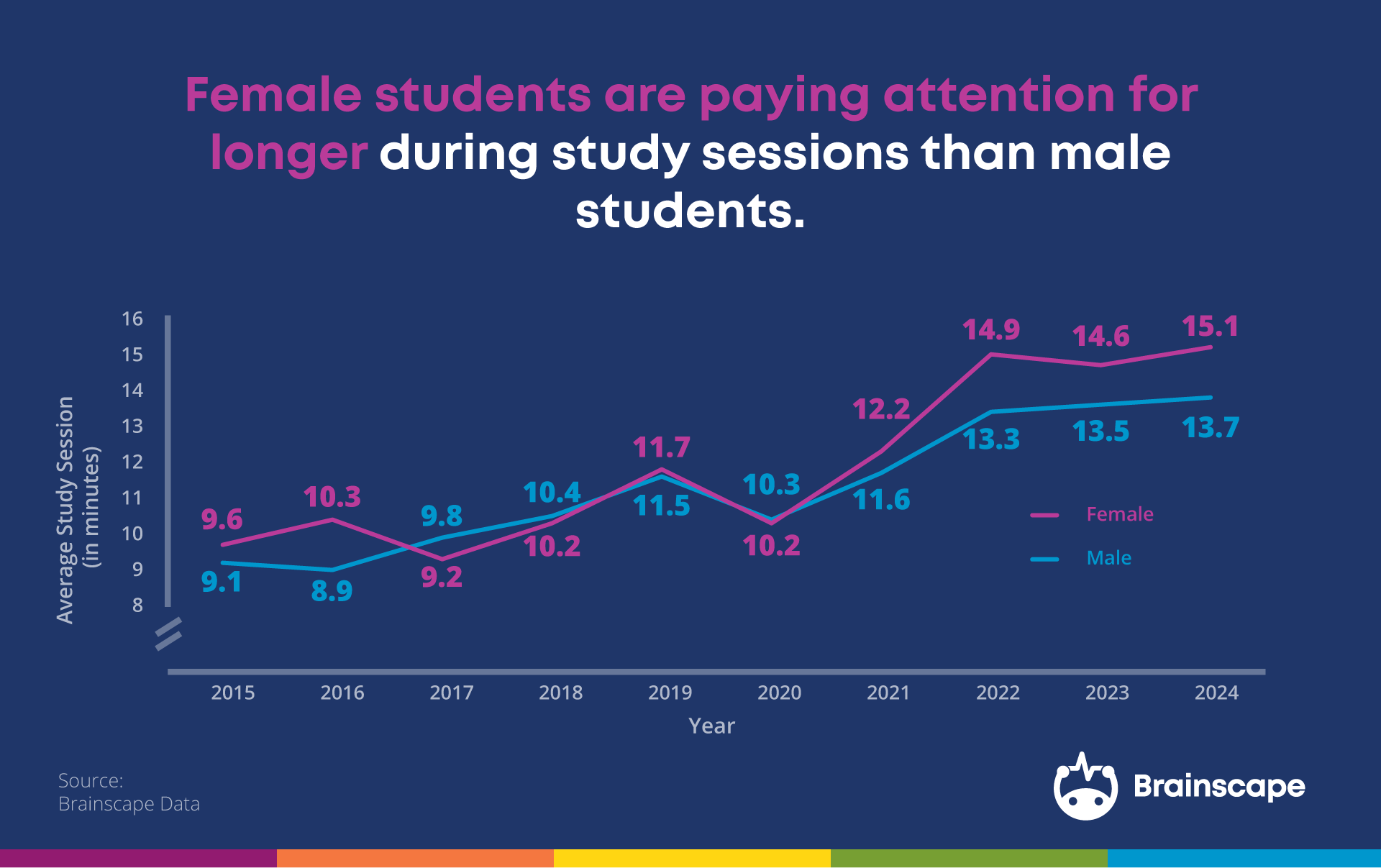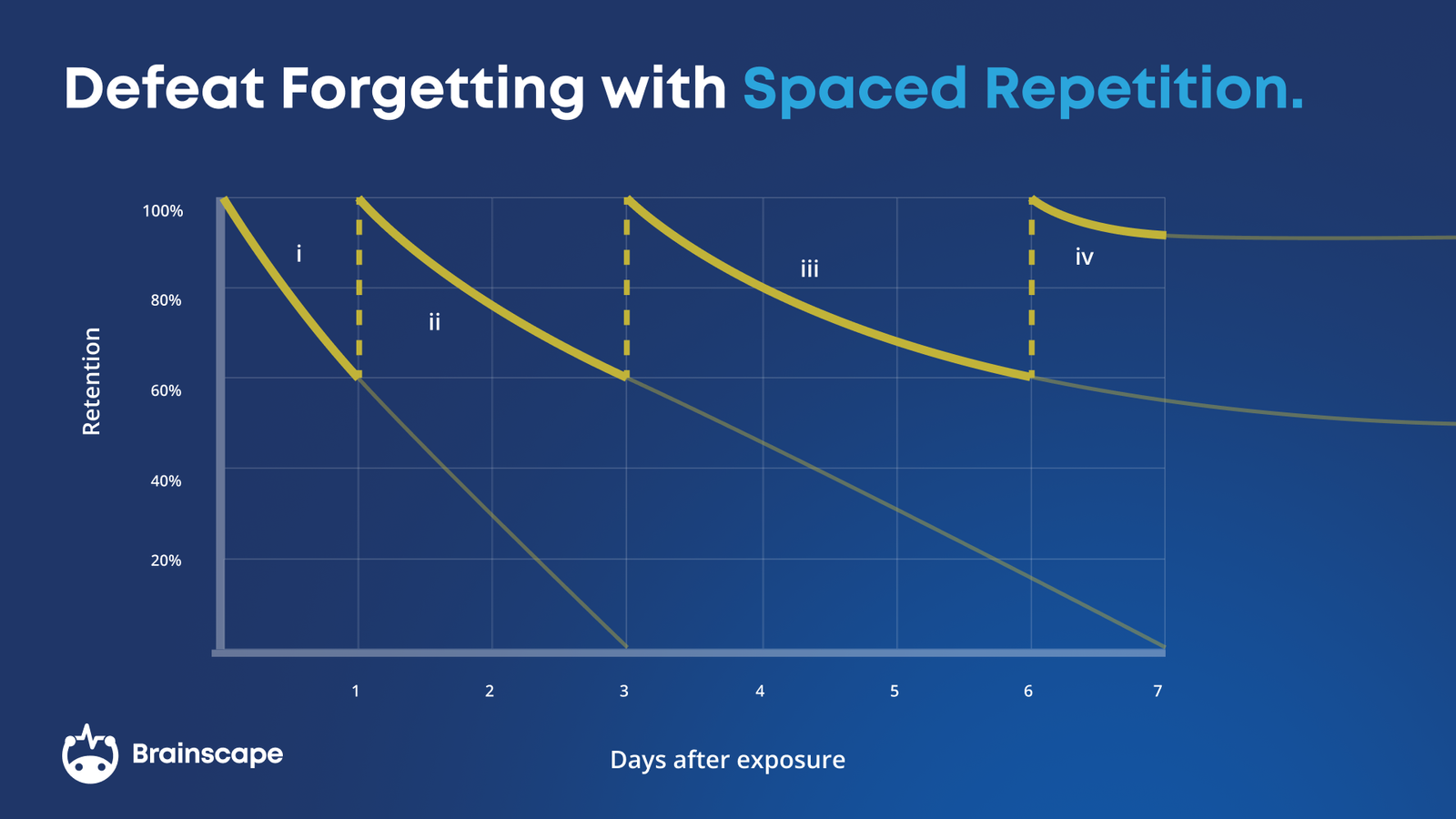The prevailing wisdom is pretty set: according to many experts, attention spans have dropped off a cliff over the past two decades. But new data from a study app called Brainscape—an adaptive flashcard platform—reveals that over the past 10 years, its 6 million users have been putting in longer and longer study sessions*.
This begs the following questions: how is it possible that students’ attention spans are improving when the widely-observed trend is declining? Is it even possible to improve your attention span or is it a given trait for your particular brain anatomy? And if it is, how? Supported by the results of our attention span analysis, we’ll be answering all of these questions in this guide.
*Study sessions are the contiguous amount of time spent in the app, actively working through flashcards. Given that learners can't use the app without paying attention—reading the flashcard questions and reviewing the answers, etc.—study session length in Brainscape is a proxy for attention span.
How have attention spans changed over time?
The purported decline in average attention span is often attributed to advances in technology, social media, and unprecedented access to information thanks to the mobile devices everyone of every socioeconomic class owns.
Short video clips, like those found on TikTok or Instagram Reels, have become the most widely consumed content for younger generations. Even average movie shots are getting shorter, dropping from 12 seconds in 1930 to an average of just 2.5 seconds. Newspaper articles have become significantly shorter too, with the estimated reading length often provided at the top of the page.
“Our attention span averages 47 seconds on a screen, and it is shrinking.” - Gloria Mark, PhD
A study by expert Gloria Mark, who received her PhD in psychology from Columbia University, found that in 2004 the average span of attention was 150 seconds long. By 2012, the average attention span declined to half that at 75 seconds, and by 2018, they decreased even further to a very short 47 seconds.

Over the past several years, this low attention span average has been replicated by other researchers to within a few seconds.
You’d think these trends towards a state of constant distraction would be catastrophic for students’ academic performance. Instead, a comprehensive analysis of over 6 million students has revealed that the opposite trend is true for study habits. The attention spans of top students have actually been improving over the past 10 years.
Attention spans while studying are increasing
While already short attention spans seem to be worsening worldwide, Brainscape’s analysis of over 6 million people revealed that this wasn’t the case when it came to the attention span of students using the platform to study. Using raw data on the length of study sessions, Brainscape found that the average study session has increased by 53% over the past ten years. In 2015, the average study session for a Brainscape user was 9.4 minutes, and by 2024 the average session had increased to 14.4 minutes.
(Remember, study sessions are the contiguous amount of time actively working through flashcards. Given that learners can't use the app without paying attention, study session length in Brainscape is a proxy for attention span.)

While a 5-minute increase may not seem like much, it needs to be considered in the context of a single study session, defined as opening the app to work through 10, 20, 30, or more flashcards in a single sitting. A student could complete multiple study sessions in a single day, which would then translate into 10 minutes (2 sessions), 15 minutes (3 sessions), or 20 minutes (4 sessions) of additional studying per day, compared with 10 years ago.
Add this up over the standard work week of 5 days and you’ve got as much as 1 hour 40 minutes more time devoted to learning on top of what they're already doing. In one month, that’s 6.67 hours of additional learning. In one year, 80 hours, which is enough time to learn to swim, become proficient in cooking, and get a first aid certification.
In other words, those extra minutes of studying compound tremendously over time. Even if a student studies for just 5 extra minutes each day, that’s 30.5 hours of additional time spent studying each year. That is a huge difference, especially when taking the benefits of spaced repetition into account.
And women are doing even better than men...

Another finding is that the average attention span of female-identified students is not only longer than their male-identified counterparts but has increased at a faster rate too.
Between 2015 and 2024, female users extended their average study session times to 15.1 minutes, while the average study session for male users increased to 13.7 minutes. In other words, on average, women study for 1.4 minutes longer than men do every time they sit down to study.
Assuming three short study sessions per day, that additional study time equates to 4.2 minutes per day, 21 minutes per week, and 1 hour 20 minutes per month: the standard length of a feature film.
How are students improving their attention spans while studying?
The 53% increase in study session length flies in the face of the prevailing wisdom that attention spans are decreasing, as supported by Mark’s and others’ research. But perhaps more importantly, it illustrates that attention spans are not static things. Like any muscle in the body, you can build and lengthen your attention span, even for cognitively taxing tasks like studying.
If six million students could increase their attention span by 5 minutes per study session, so can you. The question is how.
The answer is that if you tap into the way the human brain was biologically designed to learn, then learning is going to feel a lot less painful and taxing, allowing you to learn for longer before becoming fatigued.
Brainscape does exactly this through a study algorithm that is based upon the learning principles underpinning the cognitive science of how brains learn:
Spaced Repetition

Spaced repetition involves your repeated exposure to concepts based upon how well you understand them. This requires breaking a subject down into its atomic parts, framing them as question-and-answer pairs (as flashcards do), and then repeating each concept based on your confidence in how well you understand them.
In Brainscape, students are required to rate how well they understood a flashcard on a scale of 1 to 5 with 1 being “not at all” and 5 being “perfectly”. Flashcards rated 1’s and 2’s get repeated very often, while those rated 4’s and 5’s much less often, which promotes faster, more efficient learning.
Active Recall
Active recall involves the retrieval of information from memory, rather than recognizing it in your study notes or in a selection of multiple-choice answers. Flashcards are the perfect tool for active recall because they frame every concept as a question, which your brain is then compelled to answer by retrieving the information from memory. This strengthens the brain’s neural pathways to that information, building memory much faster.
Moreover, feeling the burn of the knowledge gap—for the questions you don’t know the answer to—really motivates the brain to hold on to that information for longer.
Metacognition
Metacognition is the self-reflection you do on how well you understand a concept. In other words, it’s “thinking about your thinking”. After flipping over a flashcard, Brainscape asks you to rate how well you knew that concept, which compels you to reflect on your understanding. This establishes additional memory hooks to that concept, allowing it to leave a deeper impression, thereby enhancing memory.
Accessibility, anytime, anywhere
Brainscape is instantly accessible as an app on any device, synchronous across multiple devices, and even allows students to download flashcards for offline study. In other words, no matter where you are—college-bound on a bus or Cambodia-bound on an Airbus A380—you’re never more than a tap or two away from engaging in impactful, efficient studying for any subject or exam.
Study metrics making progress visible
The ability to see your study progress over time is a great motivator for students to keep up with their study habits. Thanks to technology, it’s easier than ever to measure and view your progress, and to hold yourself accountable. Seeing the progress in real-time also motivates students to keep up their study pace, or even surpass it to earn a better score on the next exam.
A checklist for increasing your attention span
Spaced repetition, active recall, metacognition, accessibility, and study metrics are all ways that Brainscape has managed to increase the average attention span of its learners over the past 10 years. Through constant improvements to its flashcard algorithm and study experience, students have found learning increasingly more efficient and less painful, motivating them to spend more and more time studying with the app.
But outside of this study tool, there are many immediately actionable ways you can optimize your attention span. In this article—12 Focus exercises to build your attention span like a muscle—you’ll find a checklist of 12 exercises you can use to eliminate distractions and improve your intrinsic ability to focus better, no matter what’s going on around you.
In conclusion…
Armed with a learning technology that optimizes study efficiency and minimizes inertia, top students have managed to increase their attention spans dramatically against a backdrop of dramatically decreasing attention spans. If you would like to join this counter-narrative and supercharge your study productivity, you can browse Brainscape’s library, featuring millions of flashcards made by top students, professors, publishers, and experts, spanning hundreds of subjects; or create your own completely free.
